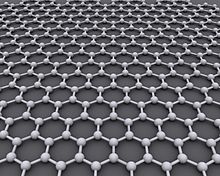
Back Grafeno AN غرافين Arabic Qrafen Azerbaijani Grafens BAT-SMG Графен Byelorussian Графэн BE-X-OLD Графен Bulgarian গ্রাফিন Bengali/Bangla Grafen BS Grafè Catalan

Graphene (/ˈɡræfiːn/[1]) is an allotrope of carbon consisting of a single layer of atoms arranged in a hexagonal lattice[2][3] nanostructure.[4] The name is derived from "graphite" and the suffix -ene, reflecting the fact that the graphite allotrope of carbon contains numerous double bonds.
Each atom in a graphene sheet is connected to its three nearest neighbors by σ-bonds and a delocalised π-bond, which contributes to a valence band that extends over the whole sheet. This is the same type of bonding seen in carbon nanotubes and polycyclic aromatic hydrocarbons, and (partially) in fullerenes and glassy carbon.[5][6] The valence band is touched by a conduction band, making graphene a semimetal with unusual electronic properties that are best described by theories for massless relativistic particles.[2] Charge carriers in graphene show linear, rather than quadratic, dependence of energy on momentum, and field-effect transistors with graphene can be made that show bipolar conduction. Charge transport is ballistic over long distances; the material exhibits large quantum oscillations and large and nonlinear diamagnetism.[7] Graphene conducts heat and electricity very efficiently along its plane. The material strongly absorbs light of all visible wavelengths,[8][9] which accounts for the black color of graphite, yet a single graphene sheet is nearly transparent because of its extreme thinness. Microscopically, graphene is the strongest material ever measured.[10][11]

Scientists theorized the potential existence and production of graphene for decades. It has likely been unknowingly produced in small quantities for centuries, through the use of pencils and other similar applications of graphite. It was possibly observed in electron microscopes in 1962, but studied only while supported on metal surfaces.[12]
In 2004, the material was rediscovered, isolated and investigated at the University of Manchester,[13][14] by Andre Geim and Konstantin Novoselov. In 2010, Geim and Novoselov were awarded the Nobel Prize in Physics for their "groundbreaking experiments regarding the two-dimensional material graphene".[15] High-quality graphene proved to be surprisingly easy to isolate.
Graphene has become a valuable and useful nanomaterial due to its exceptionally high tensile strength, electrical conductivity, transparency, and being the thinnest two-dimensional material in the world.[4] The global market for graphene was $9 million in 2012,[16] with most of the demand from research and development in semiconductor, electronics, electric batteries,[17] and composites.
The IUPAC (International Union for Pure and Applied Chemistry) recommends use of the name "graphite" for the three-dimensional material, and "graphene" only when the reactions, structural relations, or other properties of individual layers are discussed.[18] A narrower definition, of "isolated or free-standing graphene" requires that the layer be sufficiently isolated from its environment,[19] but would include layers suspended or transferred to silicon dioxide or silicon carbide.[20]
- ^ Cite error: The named reference
camdicwas invoked but never defined (see the help page). - ^ a b Cite error: The named reference
geim2007was invoked but never defined (see the help page). - ^ Cite error: The named reference
peres2009was invoked but never defined (see the help page). - ^ a b [1] "Carbon nanostructures for electromagnetic shielding applications", Mohammed Arif Poothanari, Sabu Thomas, et al., Industrial Applications of Nanomaterials, 2019. "Carbon nanostructures include various low-dimensional allotropes of carbon including carbon black (CB), carbon fiber, carbon nanotubes (CNTs), fullerene, and graphene."
- ^ Cite error: The named reference
zdet2015was invoked but never defined (see the help page). - ^ Cite error: The named reference
harris2018was invoked but never defined (see the help page). - ^ Cite error: The named reference
lizhi2015was invoked but never defined (see the help page). - ^ a b Cite error: The named reference
nair2008was invoked but never defined (see the help page). - ^ a b Cite error: The named reference
zhu2014was invoked but never defined (see the help page). - ^ Cite error: The named reference
lee2008was invoked but never defined (see the help page). - ^ Cite error: The named reference
cao2020was invoked but never defined (see the help page). - ^ Cite error: The named reference
boehm1962awas invoked but never defined (see the help page). - ^ Cite error: The named reference
novo2004was invoked but never defined (see the help page). - ^ Cite error: The named reference
aps2009was invoked but never defined (see the help page). - ^ "The Nobel Prize in Physics 2010". Nobel Foundation. Retrieved 1 September 2021.
- ^ Cite error: The named reference
azon2014was invoked but never defined (see the help page). - ^ Cite error: The named reference
mrmak2014was invoked but never defined (see the help page). - ^ Cite error: The named reference
IUPAC2009was invoked but never defined (see the help page). - ^ Cite error: The named reference
geim2009awas invoked but never defined (see the help page). - ^ Cite error: The named reference
ried2009was invoked but never defined (see the help page).
© MMXXIII Rich X Search. We shall prevail. All rights reserved. Rich X Search